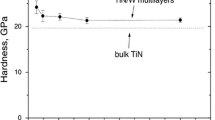The effect of the metal-layer geometry and of the interface structure on the fracture toughness of multilayer metal–ceramic composites is examined. The samples are produced by free sintering of layups consisting of alternating metal and ceramic layers. The ceramic layers are prepared by rolling fine pyrophyllite powders into strips. The metal layers are prepared from stainless steel fabric. Before sintering, the layups are pressed across and along the layers. The samples show 24–25% residual porosity after the free sintering of layups containing 15 vol.% metal phase at 1000°C. The fracture energy of the samples is determined. Their microstructure is examined. It is shown that the use of metal fabric substantially increases the fracture energy of composites. This is due to the developed skeleton structure of multilayer ceramic–metal fabric composites, which weakens the adverse effect of the residual porosity and sometimes poor adhesive contact between the metal and ceramic components on fracture toughness.
Similar content being viewed by others
References
M. Ruble and A. G. Evans, “High toughness ceramics and ceramic composites,” Prog. Mater. Sci., 33, 85 (1989).
L. S. Sigl, P. A. Malaga, B. J. Dalgieish, et al., “On the toughness of brittle materials reinforced with a ductile phase,” Acta Metal., 36, 945 (1988).
P. Duhceyne and L. L. Hench, “The processing and statistic mechanical properties of metal fiber reinforced bioglass,” J. Mater. Sci., 17, 595–606 (1982).
M. Bannister and M. F. Ashby, “The deformation and fracture of constrained metal sheets,” Acta Metal. Mater., 39, 2575–2582 (1991).
V. V. Skorokhod, “Layered composites: structural classification, thermophysical and mechanical properties,” Powder Metall. Met. Ceram., 42, No. 9–10, 437–446 (2003).
M. M. Sharme and M. F. Amatean, “Processing of laminated hybrid ceramic composites,” in: 3rd Intr. Conf. Composites Engineering, New Orleans (1996), 751–754.
D. R. Leusuer and R. A. Riddle, “Fracture toughness and impact properties of laminated metal composites,” in: 3rd Int. Conf. Composites Engineering, New Orleans (1996), 509–512.
Zheng Chen and J. J. Mecholsky, “Toughening by metallic lamina in nickel/alumina composites,” J. Am. Ceram. Soc., 76, No. 5, 1258–1264 (1993).
B. D. Flinn, M. Ruehle, and A. G. Evans, “Toughening in composites of Al2O3 reinforced with Al,” Acta Metal., 37, 3001 (1989),
V. V. Krstic, P. S. Nicholson, and R. G. Hoagland, “Toughening of glasses by metallic particles,” J. Am. Ceram. Soc., 64, 499 (1988).
L. Shepeleva, B. Medres, W. D. Kaplan, et al., “Laser induced Cu/Alumina bonding: Microstructure and bond mechanism,” Surface Coat. Techn., 125, 40–44 (2000).
V. Curicuta, D. R. Alexander, Y. Liu, et al., “Furnace and laser methods bonding metals to ceramics: interface investigation,” Mat. Sci. Eng., B68, 196–203 (2000).
Z. Chen and J. J. Mecholsky, “Control of strength and toughness of ceramic/metal laminates using interface design,” J. Mater. Res., 8, No. 9, 2362–2369 (1993).
Z. Chen, J. J. Mecholsky, and S. Hu, “Effect of interface design on high-temperature of laminated composites,” J. Mater. Res., 11, No. 8, 2035–2041 (1996).
B. W. Sheldon and J. Rankin, “Step-energy barriers and particle shape changes during coarsening,” J. Am. Ceram. Soc., 85, 683–390 (2002).
V. P. Katashinsky and Yu. M. Solonin, “The rolling of the strip metal-hydride electrodes,” in: Hydrogen Materials Science and Chemistry of Metal Hydrides, Kluwer Academic Publishers, The Netherlands (2002), 105–113.
S. M. Kats, V. N. Bogin, S. S. Ordan’yan, et al., “Multilayer metal-oxide composites based on cast plasticized films with powder fillers,” Powder Metall. Met. Ceram., 25, No. 10, 850–856 (1986).
V. V. Skorokhod, S. M. Solonin, V. P. Katashinksii, et al., “Features of skeletal composite compaction and sintering,” Powder Metall. Met. Ceram., 45, No. 7–8, 304–310 (2006).
Author information
Authors and Affiliations
Corresponding author
Additional information
Translated from Poroshkovaya Metallurgiya, Vol. 48, No. 1–2 (465), pp. 29–36, 2009.
Rights and permissions
About this article
Cite this article
Skorokhod, V.V., Panichkina, V.V., Radchenko, P.Y. et al. Effect of metal-layer structure on the mechanical properties of multilayer metal–ceramic composites. I. fracture energy. Powder Metall Met Ceram 48, 21–26 (2009). https://doi.org/10.1007/s11106-009-9102-2
Received:
Published:
Issue Date:
DOI: https://doi.org/10.1007/s11106-009-9102-2




